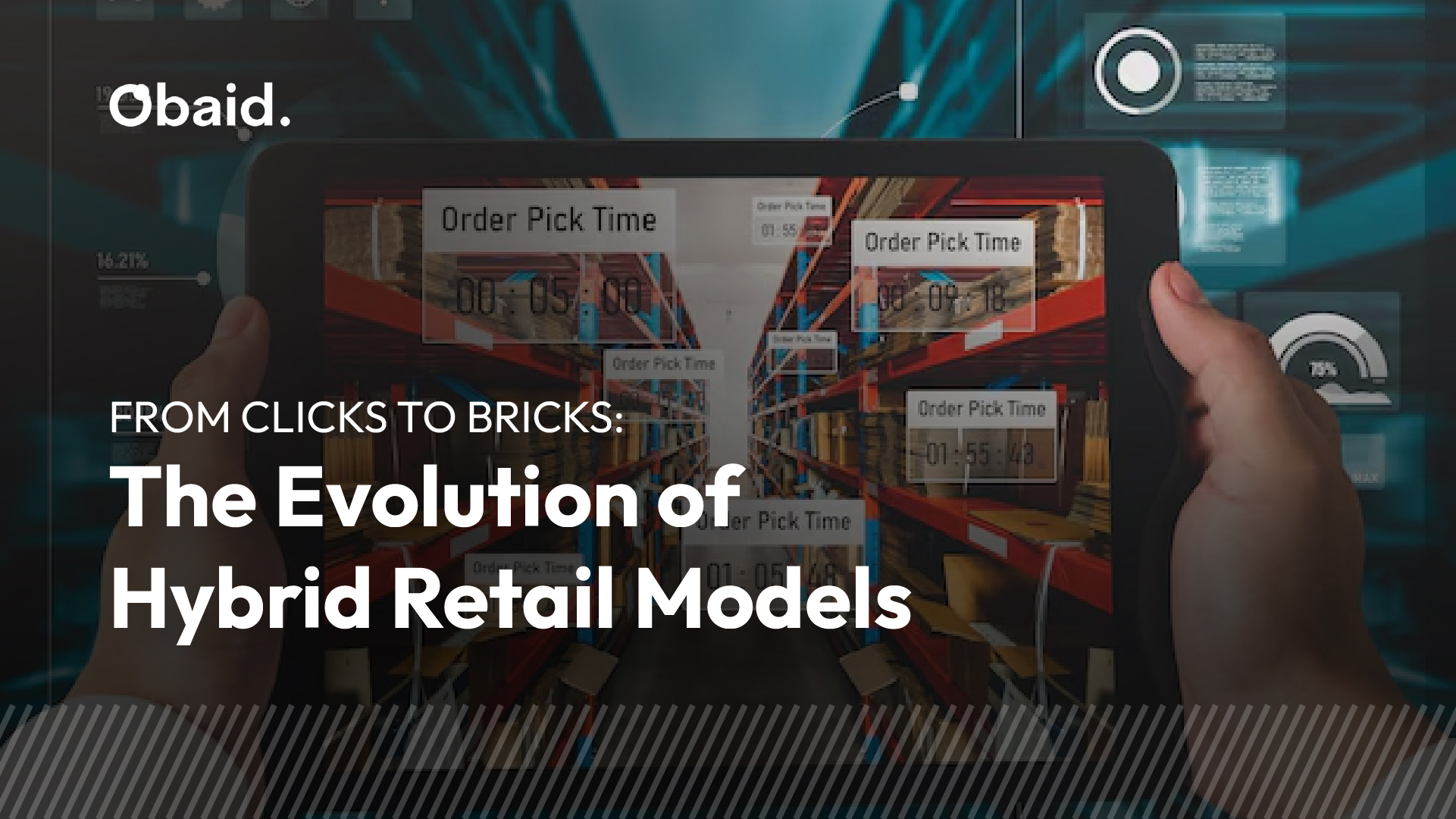From Clicks to Bricks: The Evolution of Hybrid Retail Models
Published on August 12, 2024

Imagine a time before the internet when shopping from home seems fictional. In the period of the internet, smartphones, and laptops the scenario changed. The Internet began to transform the retail. Online shopping quickly became popular, offering a futuristic way to buy things without ever going to a store. However, as exciting as this new way of shopping was, it faced some big challenges as well. Many early online retailers struggled with issues like customer service and logistics. Eventually, the best solution came from blending the retail trends i.e. merging the online world with traditional physical stores. This mix, known as the hybrid retail model, combines the strengths of both approaches to create a seamless shopping experience.
The Story of Evolution
At the beginning of the online retail trend, the big name which can be quoted is Amazon. It showed how the power of the internet can be used to change the way we shop. They make the browsing and purchasing of products easy. people who have spare time and go out shopping can then buy things from home. Amazon offers a huge list of items to select from making shopping more convenient than ever. These early online retailers saw huge success. They grew quickly and attracted a lot of customers who loved the idea of shopping online, free from store hours and location limitations.
Despite their initial success, many of these early online businesses faced major problems:
- Managing inventory, shipping orders on time, and handling returns were tough challenges for online stores.
- Brand awareness and trust were a major issue. Unlike well-established stores with strong reputations, new online retailers had to work hard to build trust and get noticed.
- Competing with well-known physical stores requires huge marketing budgets, putting pressure on online startups.
As online shopping grew, traditional stores realized they could also benefit from the Internet. Brands like Nishat Linen, Saphire, Alkaram Studio, and many more started to sell online, using their existing brand recognition and loyal customer bases which proved advantageous. This combination of online and physical locations marked a new era. These retailers created a “clicks-and-bricks” model, which is the blend of their physical stores with an online store. it helped to enhance the shopping experience for customers. The hybrid retail model in Pakistan became a powerful way to overcome the challenges faced by early online retailers.
If we look at the international brands, Nike has nailed it. It portrays a perfect example of a hybrid retail model where customers can explore Nike’s online product catalog from the comfort of their homes and can try them on by visiting nearby physical stores in person. The chosen product is placed in the personal locker for customers at Nike’s physical retail store. Using the Nike app, a customer can unlock the locker and try on the sneakers. If they fit just right, he can complete the purchase directly through the app by scanning the product barcodes. No need to wait in line or deal with a cashier, everything happens smoothly and efficiently via phone.
This hybrid retail model not only offers the convenience of online shopping but also the tactile experience of in-store browsing. Nike’s approach highlights how blending digital and physical retail can enhance the customer journey and drive significant growth, like their impressive 19% increase in digital sales in early 2022. It’s a prime example of how companies can innovate by integrating their online and offline channels to create a unique and engaging shopping experience.
The Impact of Hybrid Models on Customer Behavior
In 2005, a study by Jupiter Communications Inc. showed an interesting trend. U.S. shoppers were expected to spend over $632 billion in physical stores, even though they researched and compared products online first. This showed that most of the customers searched for products on the internet first and then went to stores to buy them. This shows that for a brand having an online store is a must because it helps to attract more customers thus boosting sales.
A Hybrid Retail Model has Categories
A Hybrid retail model represents a strategic blend of online and offline elements, designed to offer a more cohesive and seamless shopping experience. These models can be categorized into several key approaches:
1. Omnichannel Shopping
Omnichannel shopping is a customer-centric approach that ensures a seamless shopping experience across all retail channels. Customers can interact with a brand through various touchpoints i.e. online, in-store, via mobile apps, and more, without experiencing friction between channels. Key features include:
- Customers can view real-time inventory across online and physical stores, ensuring they have accurate information on product availability.
- A cohesive brand message and experience across all channels enhances customer recognition and loyalty.
- Customers can receive support through various channels, including live chat, email, phone, and in-store assistance.
2. Click-and-Collect
Click-and-collect, also known as buy online, pick up in-store (BOPIS), allows customers to order products online and pick them up at a physical store. This model offers several advantages:
- Customers can avoid logistics fees and save time by picking up their orders at a nearby location.
- Products are ready for collection as soon as they arrive at the store, often on the same day or within a few hours.
- Customers have the opportunity to explore additional products and make impulse purchases during their store visits.
3. In-Store Digital Integration
To enhance the physical shopping experience, many retailers have introduced digital technologies in-store. These innovations include:
- Interactive kiosks allow customers to search for products, check availability, and place orders directly from the store.
- AR technology enables customers to visualize products in their own space or try virtual fittings for clothing and accessories.
- Store-specific mobile apps offer features such as digital coupons, loyalty programs, and store navigation assistance.
Benefits You Can Get
Here’s the fruit:
- By allowing customers to research and compare products online, you save them valuable time. They can make informed decisions and then conveniently complete their purchases in-store. Plus, returning online orders in person eliminates the wait for refunds and avoids additional logistics costs.
- Offer various ways for customers to receive their purchases, such as in-store pickup for online orders. This not only meets diverse customer preferences but also speeds up product access and boosts satisfaction.
- Expand your reach by leveraging both online and physical channels. This multi-touchpoint approach drives higher sales and helps capture a broader audience.
- Provide a unified, consistent, and seamless shopping experience across both online and offline channels. This integrated approach builds customer trust and promotes repeat business.
- Efficient Inventory Management: Utilize online systems for efficient inventory management monitoring inventory levels in your physical stores. This prevents stockouts and ensures customers find what they need, enhancing overall satisfaction.
- Maintain a strong and consistent brand identity across all channels. A unified presence helps reinforce your brand and create a more engaging customer experience.
- Implement in-store kiosks and digital tools to simplify returns, and repairs, and provide personalized recommendations. These enhancements make the shopping process more efficient and offer real-time support to your customers.
Face the Challenges
Challenges shouldn’t be overlooked, beware of issues that might come your way:
1. Technology Integration
Integrating digital technologies into physical stores requires significant investment and careful planning. Retailers must ensure that their technology solutions are compatible with existing systems and provide a seamless shopping experience for customers.
2. Data Management
In the case of multichannel retail managing data across various channels can be complex. Retailers must implement robust data management systems to ensure accurate inventory tracking, customer data integration, and effective analytics. Ensuring data privacy and security is also critical in maintaining customer trust.
3. Customer Expectations
Customer expectations are continually evolving, and retailers must stay ahead of trends to remain competitive. A hybrid retail model requires ongoing innovation and adaptation to meet changing customer preferences and technological advancements.
4. Operational Complexity
Running a hybrid retail operation involves coordinating multiple channels, inventory management across locations, and ensuring consistent service quality. Retailers must invest in training and process optimization to handle the complexity and deliver a cohesive experience.
Extract of Discussion
Having just a physical or online store is not beneficial to your business. If you want to expand fast and boost sales, accepting the hybrid retail model is essential. Furthermore, don’t forget to integrate your online and offline store because it provides convenience to your customers. Clicks to Bricks model lets you meet customers where they are offering multiple ways to engage with your brand.

Obaid Arshad
CEO & Co-Founder
